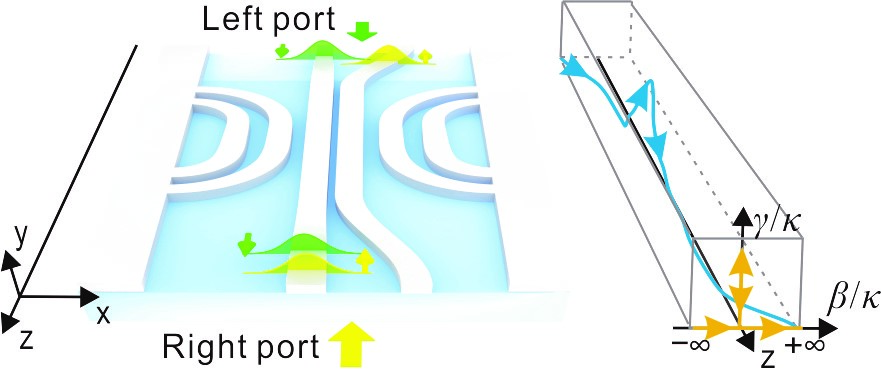In non-Hermitian systems, two or more eigenvalues and eigenstates of a resonant system coalesce at Exceptional points (EPs). Dynamic encircling of EPs has received significant interest in recent years, as it leads to highly nontrivial phenomena, such as chiral transmission in which the final state of the system depends on the encircling handedness. Previously, chiral transmission for a pair of eigenmodes has been realized by a closed dynamical trajectory in parity-time- (PT-) or anti-PT-symmetric systems. Although chiral transmission of symmetry-broken modes is more accessible in practical photonic integrated circuits, the demonstrated transmission efficiency is very low due to path-dependent losses.
In a new paper (https://doi.org/10.1038/s41377-024-01409-1) published in Light Science & Applications, a team of scientists, led by Professor Lin Chen from Wuhan National Laboratory for Optoelectronics and School of Optical and Electronic Information, Huazhong University of Science and Technology, Wuhan 430074, China, and co-workers have reported chiral conversion between modes localized in individual waveguides. Beyond the previous closed EP-encircling evolution trajectory, an open evolution trajectory is explored, taking advantage of asymptotic modes at two different infinite points, but not (anti-) symmetrical modes (PT-symmetric systems) or symmetry-broken modes (anti-PT-symmetric systems) (Figure 1).
In such a dynamical non-Hermitian system, non-adiabatic jumps (NAJs), – the key factor for inducing a chiral response – originate from coupling loss selectively to one of the eigenmodes during the evolution.
The chiral dynamics is theoretically and experimentally demonstrated. The resultant chiral mode converters based on coupled silicon waveguides can localize optical energy within a single waveguide with high-efficiency transmission (Figure 2).
The chiral mode converters based on open evolution trajectories introduces loss by an adiabatic coupler, instead of metal applied in previous schemes, which relaxes the fabrication requirements.
The results offer a new approach to study chiral dynamics in non-Hermitian systems, and open new avenues for the development of practical asymmetric-transmission devices and applications.
###
References
DOI
Original Source URL
https://doi.org/10.1038/s41377-024-01409-1
Funding information
This work was supported by National Natural Science Foundation of China (Grant No. 12074137), National Key Research and Development Project of China (Grant No. 2021YFB2801903), Science, Technology and Innovation Commission of Shenzhen Municipality (Grant No. JCYJ20220530161010023), and State Key Laboratory of Advanced Technology for Materials Synthesis and Processing (Wuhan University of Technology).
About Light: Science & Applications
The Light: Science & Applications will primarily publish new research results in cutting-edge and emerging topics in optics and photonics, as well as covering traditional topics in optical engineering. The journal will publish original articles and reviews that are of high quality, high interest and far-reaching consequence.
